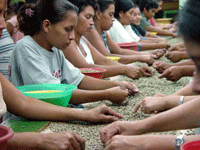
Most fine coffee goes through a battery of machines that sort the coffee by density of bean and by bean size, all the while removing sticks, rocks, nails, and miscellaneous debris that may have become mixed with the coffee during drying. First machines blow the beans into the air; those that fall into bins closest to the air source are heaviest and biggest; the lightest (and likely defective) beans plus chaff are blown in the farthest bin. Other machines shake the beans through a series of sieves, sorting them by size. Finally, an ingenious machine called a gravity separator shakes the sized beans on a tilted table, so that the heaviest, densest and best vibrate to one side of the pulsating table, and the lightest to the other.


Molecular density sorting is one of the best ways to separate broken, small, undeveloped, and otherwise defective coffee beans. There are usually 2-3 stages of density sorting. In the first stage, the very dense rocks and stones are removed from the coffee. In the second stage, the coffee is hulled and the debris is removed. The third stage is most important and uses a densimetric table to separate the coffee into three or more densities. The settings on the machine must be continuously monitored to ensure that proper density sorting is occurring. The light and less dense coffee beans move to the right bottom side of the table, whereas the dense high-quality coffee beans move to the upper third of the table. This table will also remove any remaining debris that have made it through the previous density sorting stages. If the coffee mill is concerned with attaining the highest quality coffee possible, it may run the upper third coffee again to further separate any small deviations in density.


The final step in the cleaning and sorting procedure is called color sorting, or separating defective beans from sound beans on the basis of color rather than density or size. Color sorting is the trickiest and perhaps most important of all the steps in sorting and cleaning.
Color sorting is frequently used to remove the defective coffee beans that were not removed during coffee processing or hulling. Many countries sort coffee beans by hand due to inexpensive labor, but for most countries investment in a color sorting machine, or color separator, is necessary.
The methodology behind color sorting machines is similar. The color of each coffee bean is quickly measured using a type of CCD camera system and depending on this wavelength measurement the bean is either allowed to flow downward or is shot with a puff of air into the reject pile. Monochromatic machines remove white and black coffee beans since they have a lighter or darker hue than the average. The more specific bichromatic color sorting machines detect and eliminate coffee beans that are white, unripe, broken, insect damaged, and black.
Image Source: Esperanza Coffee and Coffee Research Information Sources: Coffee Research and Coffee Review
Drying Process | Flavor Characteristics of Drying Process | Polishing and Aging
Roasting | Home Roasting | Cupping | Decaffeination Processes


















































